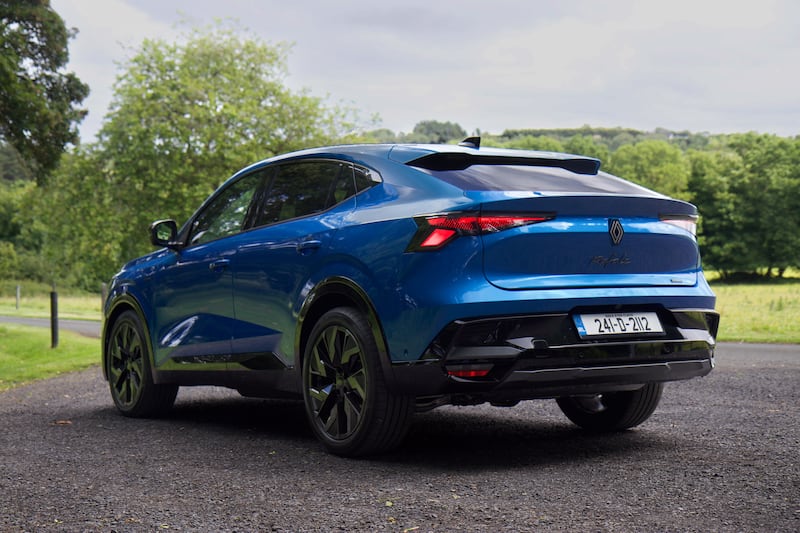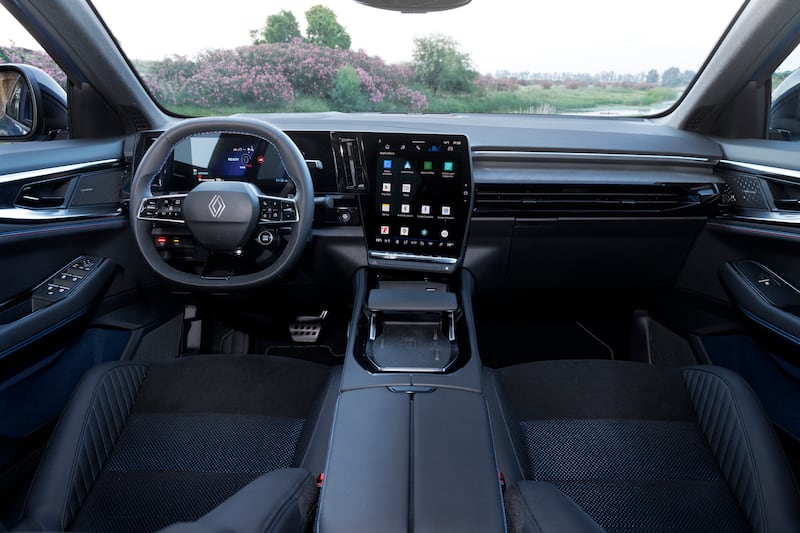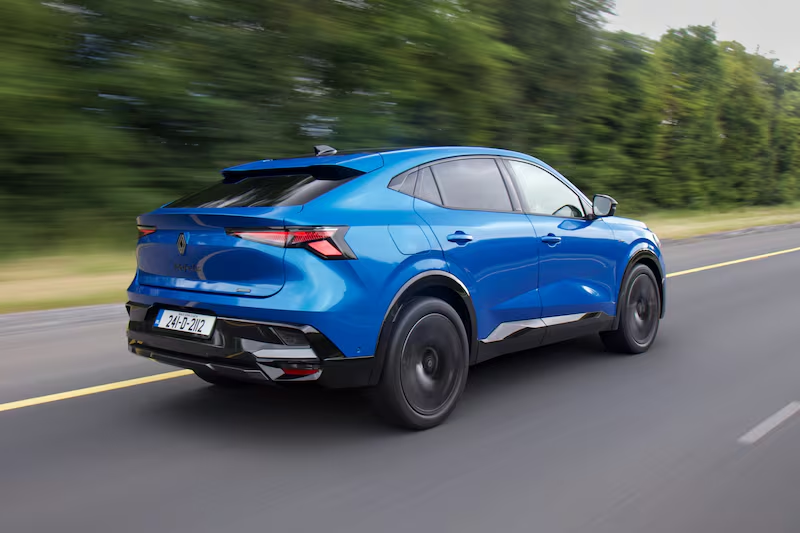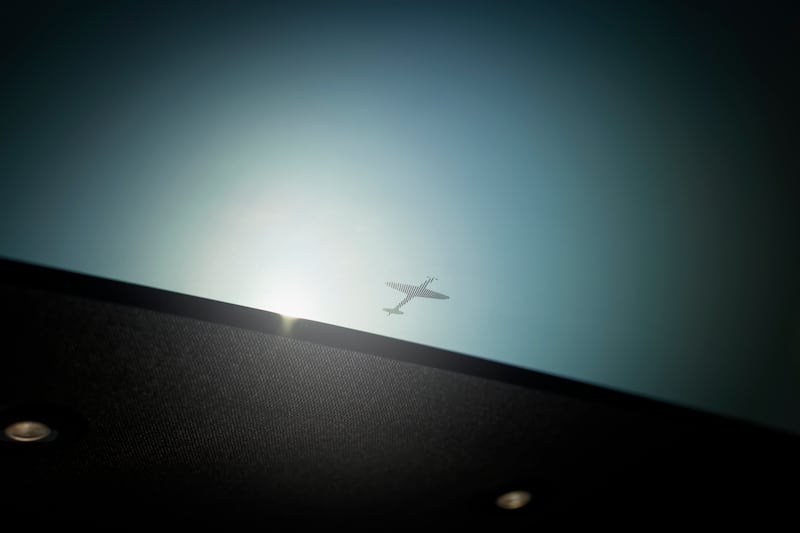I’m a sucker for a good aviation story. Is that why I like this new Renault Rafale?
It’s not a car I’m generally programmed to like. I tend not to be keen, at all, on SUVs in general – only a few have passed harmlessly under my gimlet gaze – and SUVs which have had a roof-chop to turn them into supposed coupes start me harrumphing like a 1930s film extra. Taking a car that’s supposed to be tall and practical and trying to make it low and impractical again? Harrumph, I say!
This Rafale, though, it’s somehow getting past my defences, and I suspect the aviation connection is to blame. Look at the back portion of the vast glass roof in the Rafale (the same electro-chrome roof that goes from clear to cloudy at the touch of a button as you’ll find in the new electric Scenic, and which is this year’s must-have motoring accessory) and you’ll find the outline of an aeroplane.
This is no mere gimmick, as there’s genuine connective tissue going on. Renault’s new Rafale hybrid-engined SUV-coupe (not a coupe, harrumph) is named after the Caudron C.430 Rafale, a two-seat touring aircraft of impossibly art-deco sleekness, powered by a 6.3-litre Renault engine.
READ MORE

In the 1930s, it held several outright speed records and yet could carry two people in relative comfort. Plus it was often painted a fetching shade of French racing blue. Starting to see the connections?
So perhaps it’s a bit fanciful but, as I said, I’m a sucker for anything with propellers, and given that the same Renault provided the original engine to the original Rafale aircraft (no relation to the sleek and supersonic modern-day French Armée D’el Aire Rafale strike fighter, but again the name is giving me the tingles...) then it’s good enough for me. At least for the moment, I’m on board.
Before I get physically on board, however, a note about the Rafale’s styling. Glance at it, especially from the front, and you may think less Renault and more Peugeot. There’s a definite kinship between this car and the Peugeot 3008, which is perhaps not surprising as Gilles Vidal, the Rafale’s designer, jumped ship from Peugeot to Renault in 2021.
I’m not saying he copied his own homework, but I’m equally not not saying that... True, the Renault is taller and blockier, the Peugeot slightly softer, but there’s a definite resemblance between the two, especially around the grille and lights.

Inside, the two are also quite similar. Both have cracking interiors, actually. Quality levels in the Rafale are very high, and the big screens – 12 inches for both the instruments and infotainment – are not only good to look at but they’re pretty easy to use too thanks to Google-based software and proper physical switches for the air conditioning. True, the steering column is a bit overloaded with stalks because the gear selector for the automatic transmission is on there too, but you get used to it.
The comfy seats are great, so too the squared-off steering wheel with its soft-touch fake-suede panels. I’m not sure why the centre console needs a sliding lid which uses a huge grab handle to open and close it, but it feels oddly tactile and satisfying to use, so l’ll not complain.
I’ll also not complain about rear seat space, which is absolutely fine – even the headroom under that lower roof – and the boot stretches to a gargantuan 647 litres if you include the underfloor storage. Impractical? Not a bit of it.

Like the Austral SUV, the Rafale is a bit... unusual to drive. It uses a combo of a 1.2-litre three-cylinder petrol engine and an electric motor to deliver 200hp, and 200Nm of torque from the engine, backed up by 205Nm from the electric motor (it’s not as simple as adding those two figures together to get the total torque figure but it’s certainly brisk off the line).
It’s a good set-up in that there’s plenty of poke, especially when you remember to select Sport mode from the little button on the steering wheel, but also good economy – 6.2 litres per 100km is easy, even if the claimed 4.7 litres per 100km is likely out of reach.
However, it’s odd in that thanks to the wildly complicated gearbox (two electric motors, four physical gears, but technically infinite gears because of the interaction between the gears and the motors) means that the engine doesn’t always rev in time with the acceleration. Indeed, occasionally it just revs, out of nowhere, for no immediately apparent reason. The price paid for reasonable CO2 emissions? Possibly.
In terms of how it drives, the Rafale definitely feels more SUV than sporting aircraft. Alas. It’s fine – the steering is passably sporty initially, but in longer, faster corners it shows itself up as being a big, slightly soggy family car, as you’d expect from the underpinnings.

For all the sporty blue paintwork and the allusions to Renault’s Alpine sports car and racing brand, under the skin the Rafale is yet another modern SUV that rather bypasses driving fun. It’s fine, and comfortable, but not thrilling.
It also has to deal with a chunky price tag, starting from €51,495.
That’s pretty pricey for a car with a Renault badge, and compares poorly with a different Peugeot product – the new 3008 – which is not only more affordable, and can match the Rafale’s styling inside and out (albeit not its engine power in hybrid form) but is also available as a fully electric model, and that for less than the cost of the cheapest Rafale.
That gives the Peugeot a distinct edge, even given the power disparity between the two cars. Does the Peugeot have a little outline of a classic aircraft in its glass roof, though? No. No it does not. Advantage, Renault (if you’re a sad aviation geek).
- Sign up for push alerts and have the best news, analysis and comment delivered directly to your phone
- Join The Irish Times on WhatsApp and stay up to date
- Listen to our Inside Politics podcast for the best political chat and analysis













